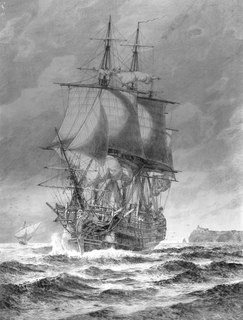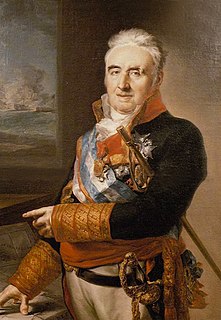
The Spanish Navy is the maritime branch of the Spanish Armed Forces and one of the oldest active naval forces in the world. The Spanish navy was responsible for a number of major historic achievements in navigation, the most famous being the voyages of Christopher Columbus to America and the first global circumnavigation by Magellan and Elcano. For several centuries, it played a crucial logistical role in the expansion and consolidation of the Spanish Empire, and defended a vast trade network across the Atlantic Ocean between the Americas and Europe, and the Manila Galleon across the Pacific Ocean between Manila and the Americas.

Miguel Ricardo de Álava y Esquivel, KB, MWO was a Spanish General and statesman who served as Prime Minister of Spain in 1835. He was born in the Basque Country, at Vitoria-Gasteiz, in 1770. Álava holds the distinction of having been present at both Trafalgar and Waterloo, fighting against the British at the former and with them at the latter.

Juan Francisco de Lángara y Huarte was a Spanish naval officer and Minister of Marine.

Santísima Trinidad was a Spanish first-rate ship of the line with 112 guns. This was increased in 1795–96 to 130 guns by closing in the spar deck between the quarterdeck and forecastle, and to 140 guns around 1802, thus creating what was in effect a continuous fourth gundeck although the extra guns added were actually relatively small. She was the heaviest-armed ship in the world when rebuilt, and bore the most guns of any ship of the line outfitted in the Age of Sail.

Ignacio María de Álava y Sáenz de Navarrete was a Spanish naval officer, present at the Battle of Trafalgar.

The Thémis was a 40-gun Coquille class frigate of the French Navy.

The Príncipe de Asturias was a Spanish three-deck 112-gun ship of the line, named after Ferdinand, eldest surviving son of Charles IV of Spain and heir apparent with the title Prince of Asturias. She served during the Napoleonic wars escorting convoys, and fought at different times against both the British and French navies. Her invocation name was Los Santos Reyes.

Bahama was a 74-gun ship of the line of the Spanish Navy. She was built in Havana on plans originally drawn by Ignacio Mullan for the 64-gun San Pedro de Alcantara, completed as a project of Gautier. She was later rebuilt as a 74-gun.
Mexicano was a 112-gun three-decker ship of the line built at Havanna for the Spanish Navy in 1786 to plans by Romero Landa. One of the eight very large ships of the line of the Santa Ana class, also known as los Meregildos. Mexicano served in the Spanish Navy for three decades throughout the French Revolutionary and Napoleonic Wars, finally being sold at Ferrol in 1815. Although she was a formidable part of the Spanish battlefleet throughout these conflicts, the only major action Mexicano participated in was the Battle of Cape St Vincent in 1797.
Conde de Regla was a 112-gun three-decker ship of the line built at Havanna for the Spanish Navy in 1786 to plans by Romero Landa. One of the eight very large ships of the line of the Santa Ana class, also known as los Meregildos. Conde de Regla served in the Spanish Navy for three decades throughout the French Revolutionary and Napoleonic Wars, finally being sold at Ferrol in 1815. Although she was a formidable part of the Spanish battlefleet throughout these conflicts, the only major action Conde de Regla participated in was the Battle of Cape St Vincent in 1797.

Real Carlos was a 112-gun three-decker ship of the line built at Havanna for the Spanish Navy in 1787 to plans by Romero Landa. One of the eight very large ships of the line of the Santa Ana class, also known as los Meregildos, Real Carlos served in the Spanish Navy during the French Revolutionary Wars and was destroyed with heavy loss of life during the Second Battle of Algeciras.

San Hermenegildo was a 112-gun three-decker ship of the line built at Havanna for the Spanish Navy in 1789 to plans by Romero Landa, one of the eight very large ships of the line of the Santa Ana class, also known as los Meregildos. San Hermenegildo served in the Spanish Navy during the French Revolutionary Wars and was destroyed with heavy loss of life during the Second Battle of Algeciras.

The Reina Luisa was a 112-gun three-decker ship of the line built at Ferrol for the Spanish Navy in 1791 to plans by José Joaquín Romero Fernández de Landa. One of the eight very large ships of the line of the Santa Ana class, also known as Los Meregildos. The Reina Luisa served in the Spanish Navy for three decades throughout the French Revolutionary and Napoleonic Wars, finally being wrecked off Béjaïa in 1815. Although she was a formidable part of the Spanish battlefleet throughout these conflicts, she did not participate in any major operations.

Salvador del Mundo was a 112-gun three-decker ship of the line built at Ferrol for the Spanish Navy in 1787 to plans by Romero Landa, one of the eight very large ships of the line of the Santa Ana class, also known as los Meregildos. Salvador del Mundo served during the French Revolutionary Wars until its capture at the Battle of Cape St Vincent by a Royal Navy fleet on 14 February 1797. Salvador del Mundo remained in British hands throughout the Napoleonic Wars, serving as a harbour ship, until it was sold and broken up in 1815.
Montañés was a 74 gun third-rate Spanish ship of the line. The name ship of her class, she was built in the Ferrol shipyards and paid for by the people of Cantabria. She was built following José Romero y Fernández de Landa's system as part of the San Ildefonso class, though her were amended by Retamosa to refine her buoyancy. She was launched in May 1794 and entered service the following year. With 2400 copper plates on her hull, she was much faster than other ships of the same era, reaching 14 knots downwind and 10 knots upwind.

The Spanish ship Argonauta was a third-rate 80 gun ship of the line of the Spanish Navy. She had 24, 18 and 8 pounder guns spread over two decks. Her usual crew was 642, though it was 956 at the Battle of Cape Finisterre and 800 at Trafalgar.

Galicia, was a Spanish third-rate ship of the line of the Kingdom of Spain's Armada Real in service between 1750 and 1797.
The Aquilón was a ship in the Spanish Navy.

Enrique MacDonell, also spelled MacDonnell, was an Irish-Spanish admiral noted for his participation in several sea battles including the Battle of Trafalgar.
















